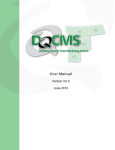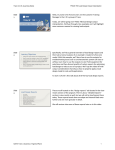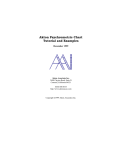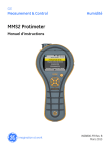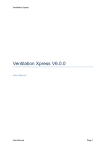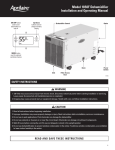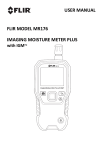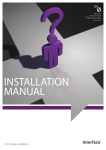Download Aprilaire 1720 Specifications
Transcript
Light Commercial Humidity Control How Big is Light Commercial? • In 2004: An estimated 1,915,000 Constant Volume RTU’s under 25 tons were sold! • 2003 Commercial Building Energy Consumption Survey list 4.9 million commercial buildings in the U.S. How many buildings does this mean to me? Buildings by Floorspace Over 500,000 200,001 to 500,000 100,001 to 200,000 50,001 to 100,000 25,001 to 50,00 10,001 to 25,000 5,001 to 10,000 1,001 to 5,000 0 250 500 750 1,000 1,250 1,500 1,750 2,000 2,250 2,500 2,750 Thousand Buildings What types of applications made up this total? Office Mercantile Service Warehouse and Storage Education Religious Worship Food Service Public Assembly Food Sales Vacant Lodging Health Care Other Public Order and Safety 0 100 200 300 400 500 600 Thousand Buildings 700 800 900 Opportunities • LC humidity control has been estimated at over $23,000,000 and is a growing market. • Humidification – The LC humidification market is estimated at 11,300 units or around $13,500,000 and growing every year! • Dehumidification – The LC dehumidification market is over $10,000,000 and growing every year! Humidity Control • In many applications, desired humidity is expressed in a range. Total humidity control is the key. • It is critical to keep the relative humidity above a certain point while not exceeding a maximum relative humidity level. The Need • • • Higher outdoor air requirements in ASHRAE 62-2 have increased the amount of ventilation air, making the need for humidity control more critical than ever When working with or storing wood products, the humidity levels must be kept in the correct range, otherwise excess moisture will cause wood to swell and expand in width and thickness and low moisture will cause shrinkage. – Cabinet and door manufacturers must maintain between 40%50% RH. – Musical instrument stores need to maintain 50% RH, excess moisture can cause swelling and popping High and low humidity can deteriorate paper products. – Libraries and archival collections must maintain between 30% 50% RH The Need • Condensation will occur if the surface temperature is at or lower than the dew-point. It can also occur if the RH% is above 50%. This condensation can lead to the corrosion of steel and iron components in the building and cause electrical systems to short circuit. • Microbiological growth can occur when space humidity levels exceed 60% RH. • ASHRAE and the EPA recommend 30%-60% for comfort in occupied spaces Application Examples • • • • • Dry Cleaners Tanning Salons Print Shops Restaurants Musical Instrument Stores • Furniture Stores • Medical Clinics • Assisted Living Facilities • Churches • Schools • Offices with Extensive Computers • Museums • Libraries • Paper/Record Storage • Film and Photographic Items Humidification • In order to keep the space comfortable and the proper amount of moisture in the air, humidity must be introduced. • Using dedicated humidifiers is the most efficient way to maintain relative humidity above the minimum level. Why Add Humidity Commercially? 1. Humidification protects materials and inventory -Essential for moisture-retaining materials such as wood, paper, fabrics, plastic, and chemicals -Condition of these materials influences their weight, dimensions, and workability -Material dehydration can lead to product deterioration -Loss of moisture can cause wood and plastics to bend, crack, and warp Why Add Humidity Commercially? 2. Humidification eliminates static electricity -Disrupts efficiency of high speed production processes and operations -Can cause paper jams in printing industry -Results in improper weaving patterns in textile industry -Damages sensitive components of electrical equipment such as computers, etc Why Add Humidity Commercially? 3. Maintains workplace comfort -Low humidity causes dry skin and itching. -Dry nose and throat can increase susceptibility to colds and respiratory illness. 4. Protects profits -Reduces machinery downtime and maintenance costs -Enhances both employee and equipment productivity Aprilaire Steam Humidifiers Models 1150, 1160, and 1180 Aprilaire Steam Humidifiers • Model 1150 – Steam output capacity of 12 lbs/hr • Model 1160 – Steam output capacity of 24 lbs/hr • Model 1180 – Steam output capacity of 48 lbs/hr Steam Humidifier Specifications Technical Specifications Model 1150 Model 1160 Model 1180 12 lb/hr 24 lb/hr 48 lb/hr 304 Stainless Steel 304 Stainless Steel 304 Stainless Steel 24.06” W x 18.93” H x 9.99” D 24.06” W x 18.93” H x 9.99” D 24.06” W x 18.93” H x 15.61” D Steam Distribution Tube 1-1/2" DIA x 16" L 1-1/2" DIA x 20” L 2” DIA x 24” L Steam Hose 1-1/2" DIA x 10’ L 1-1/2" DIA x 10’ L 2” DIA x 10’ L Operating Weight 70 lb 80 lb 120 lb Maximum Ambient Operating Temperature 80°F 80°F 80°F <60 dB 65 dB 65 dB Standard Tap or Softened Standard Tap or Softened Standard Tap or Softened Water Usage at Maximum Capacity 1.4 gal/hr 2.9 gal/hr 5.8 gal/hr Electrical Supply Voltage 240/1/60 240/1/60 240/3/60 16.7 33.3 38.5 24 VDC 24 VDC 24 VDC On/Off, 10 VDC Modulating, 0-10 VDC Modulating Humidistat Dimensions 5.95"W x 4.13"H x 1.85"D 5.95"W x 4.13"H x 1.85"D 5.95"W x 4.13"H x 1.85"D Air Flow Switch Dimensions 3.88"W x 5.81"H x 3.19"D 3.88"W x 5.81"H x 3.19"D 3.88"W x 5.81"H x 3.19"D Capacity Construction Unit Dimensions Operating Sound Level Supply Water Type Current (AMP Draw) Control Power Voltage (From Humidifier) Control Signal Internal Components Water Level Control Probe 304 Stainless Steel Construction Wall Mounting Keyholes Located on 16-inch Centers Internal Control Board Display Panel Built-in P Trap Immersion Heaters Removable Steam Chamber Component Descriptions • Water Level Control Probe – Maintains the proper amount of water in the steam chamber. • 304 Stainless Steel Construction – Ensures housing and other components exposed to water provide years of service. • Built-in P Trap – Prevents drain water from backing up into the unit while saving time and money on every installation. • Removable Steam Chamber – Quick release retention method enables easy chamber removal and cleaning from the bottom of the unit. Component Descriptions • Immersion Heaters – Designed for long life and capable of shedding mineral build-up, minimizing service calls. • Display Panel – LED’s illuminate to show system status and diagnostics for troubleshooting. • Internal Control Board – Controls all functions of the humidifier including: receiving and responding to control signals from the automatic controller, fill valve operation, steam chamber water level, heater operation, drain operation, and providing diagnostics. • Wall Mounting Keyholes – Save time and permit installation on any type of wall. Aprilaire Steam Humidifier Operation • Operation Process -After initial startup, fill valve will open and steam chamber will fill to proper level -Heating elements are energized once steam chambers is full and a call for humidity is received from the steam humidifier controller -Water is heated and boils to produce steam -Steam is delivered into the duct system through the vapor hose and the steam dispersion tube Aprilaire Steam Humidifier Operation • Build-up Removal -Boiling water in steam chamber causes minerals and impurities in the water to “drop out” which can result in a considerable amount of buildup in the steam chamber -Periodic “drain and flush” cycle is created when the steam chamber is drained while the fill valve is opened -”Drain and flush” cycle cleans steam chamber and reduces future maintenance time -Annual maintenance required with the use of standard tap water Model 1150 Control • On-Off Control -Simplest control option, unit turns completely on and off -A differential is set between on and off switch points in order to prevent output short cycling -Humidity level must fall below set point before the humidistat closes and energizes -Humidifier remains closed until humidity rises above set point -Unit is prevented from running over very short periods of time -Humidity level is controlled within 5% of set point Model 1160 and 1180 Control • Modulating Control -Demand signal is sent from a modulating humidistat to the humidifier, which then produces a proportional output ~if no signal is sent (0 VDC), no output is produced ~if a 5 VDC signal is sent, humidifier operates at 50% of capacity ~if a 10 VDC signal is sent, humidifier will run at 100% capacity -Humidifier’s electric heaters respond to the demand by cycling on and off at a corresponding rate to the demand signal -Humidity level is controlled within 3% of set points Key Aprilaire Unit Features • Relative Humidity (RH) Control ~Model 1150 controller maintains RH within 5% to 7% of set point ~Model 1160 and 1180 controller maintains RH within 2% to 4% of set point • Controller and Display Panel ~Humidifier controller, located behind removable shroud, manages all functions of the unit ~Adjustments can be made to water-type based operating parameters by changing a slide switch on the control board Display Panel on/off switch Steam Fill Drain On/Off indicator light The steam humidifier display panel shows operating status and troubleshooting information through the use of blinking indicator lights Key Aprilaire Unit Features • Indicator Lights, Status, and Description (Sample diagnostics; for all diagnostics, see I.O. & M. Manuals) ~All indicator lights blinking sequentially from right to left signals that humidifier is in a forced cool-down period prior to the start of a required automatic drain sequence ~On/Off switch is on signals that power is on; unit is functioning properly ~Slowly blinking On/Off switch signals that the electronic water level probe must be cleaned ~Fast blinking On/Off switch indicates if a probe logic fault has occurred Key Aprilaire Unit Features • Automatic Water Level Control and Safety Shut-Down ~an electronic water level probe sends a signal to the controller to either add water or turn off the heaters if insufficient or too much water exists • Three Level Water Control Probe ~allows the humidifier to electronically monitor and control the level of water in the steam chamber ~control probe has three different responses that are activated once the water level reaches an individual probe Three Level Water Control Probe Fill valve closes Fill valve opens Low-water cutoff ¼ Actions performed by humidifier when water level in steam chamber reaches each separate probe rod Key Aprilaire Unit Features • What is really in a complete kit? -Unit -Steam dispersion tube -10’ (3m) length hose -AA Steam Humidifier Controller -Air-flow detection device -Installation instructions and operation manual “Complete Kit” Aprilaire Steam Humidifier Controller Unit Steam dispersion tube Airflow detection device 10’ (3m) hose Aprilaire Included Controls • Steam Humidifier Controller (SHC) -Return duct mounted -Can be set in either the manual mode for specific RH set point control or in the automatic mode to allow for outdoor temperature compensations • Air Flow Proving Switch -Supply duct mounted -Uses the pressure differential to ensure blower operation Aprilaire Optional Controls • High Limit Switch -Highly recommended optional device -Supply duct mounted -Mounted at a minimum of 3’ (1m) downstream of the steam distribution tube -Ensures that high humidity levels do not exist in the supply duct of the HVAC system -Shuts down the humidifier in the event of out of range conditions (Typically 80-90%) Sizing Humidification TOOLS TO DO THE JOB Humidification Calculation Work Sheet Humidification Calculation Software Calculation Work Sheet Humidification Calc Software Download it free! Benefits for the Contractor • Aprilaire enables you to provide your customers with the BEST in humidification technology for light commercial projects! -Cleanable steam chamber eliminates need for costly replacement parts -Stainless steel construction is durable and reliable -Compatible with both standard and softened water -Use of softened water will allow the unit to operate for three years without requiring any service, guaranteed Benefits for the Contractor • Flexibility and ease of both installation and maintenance save you time and money! -Built in “P” Trap reduces required piping and labor on the job -Integral wall mounting system eliminates need for additional hanging material or brackets -Easy to remove and clean steam chamber provide for quick and easy servicing -Steam chamber rotation makes job site change fast and clean Benefits for the Contractor • Aprilaire is your best choice for all of your humidification needs -New opportunity to quote these units directly, for all LC applications -Over 50 years of expert experience -The same product quality and reliability you have come to expect -Sales and technical training to help you grow your business Benefits for the Contractor Features Feature Description Benefit to Contractor Stainless Steel Construction Durable, reliable long lasting Solid construction, will not have construction failure Steam chamber Cleanable steam chamber Easily to remove for clean and quick job site steam chamber rotation Water Source Ability to operate on standard or soft water Suitable for all LC applications. Use of softened water extends service life of unit up to three years Benefits for the Building Owner • Steam humidifiers save you money by protecting equipment, processes, and inventory -Reduces or eliminates maintenance and replacement costs • Improve productivity and reduce absenteeism -Proper humidity levels can prevent illness and maintain employee comfort Why Aprilaire Steam Humidifiers? • Aprilaire stands out amongst the competition!! -Complete humidification system in one box -Easily removable and cleanable steam chamber -Ability to “call” the blower -Ability to operate on all water types We’ve talked about keeping humidity above a minimum level, but what about making sure the humidity doesn’t get too high! Maximum Humidity Levels • Remember… – Humidity above 50% can cause condensation on and damage metal products. – Humidity above 50% can cause swelling and popping in wood. – Microbiological growth can occur when space humidity levels exceed 60% relative humidity. – ASHRAE and the EPA recommend that the humidity level stay in the 30%-60% range for occupied spaces. Dangers of High Indoor Humidity • Mold – Can cause sinus infections, headaches, eye and throat irritations, fatigue, loss of memory. Children are especially susceptible to moldrelated illness. – According to the EPA, dehumidifying is critical in preventing mold in buildings. • Asthma and allergy triggers – Dust mites – Cockroaches The Science Behind the Product • Before we can talk about the solution, we need to understand the science! – The Refrigeration Process • Determines how the unit operates – Psychrometrics • Determines why the unit works The Refrigeration Process What Happens in the Dehumidifier? 95°F DB 68°F WB 75°F DB 53°F DP 68°F WB 25%Rh 65°F DP 70%Rh Basics of Psychrometrics • What are Psychrometrics? – “Psychrometrics deals with thermodynamic properties of moist air and uses these properties to analyze conditions and processes involving moist air.” – In its most basic terms: the relationship between moisture and temperature • 1997 ASHRAE Handbook of Fundamentals, Chapter 6. The Psych Chart • The psychrometric chart is used to graphically show what is going on in the air as it relates to temperature and moisture. • Why we use: Shows us that if we have too much moisture how much to remove, if not enough moisture, how much to add. Key Elements of Psychrometrics • • • • • Dry bulb temperature - The temperature of the air as measured by an ordinary thermometer. Wet bulb temperature – Evaporative cooling effect in the air. Temperature is measured when a wet wick is placed over the temperature measuring device. Dew point temperature - Temperature at which moisture condenses. Relative humidity - The amount of moisture present in the air, in relation to the amount of moisture the air is capable of holding (%). Absolute humidity (humidity ratio) – True measure of the amount of moisture in the air. Measured in grains. (7000 grains = 1 lb) intersection of two known air properties… Determ ines The Rem aining Three 220 200 Grains Of Moisture Per Pound Of Dry Air 180 160 140 120 100 Dew Point 80 Hum idity Ratio 60 W et Bulb 40 Dry Bulb 20 0 25 Relative Hum idity 30 35 40 45 50 55 60 65 70 75 80 85 90 95 100 105 110 Dry-Bulb Tem perature (°F) © Am e rican Sta ndard Inc. 1 999 Fig. 3 A ir C onditioning C linic TR G-TRC 001-EN 75°F Dry Bulb 67°F Wet Bulb 70% Relative Humidity 64°F Dew Point 200 85 180 160 80 93 grains Absolute Humidity 140 75 90% 120 70 80% 70% 100 65 60% 60 80 50% 55 40% 60 50 45 30% 40 40 35(F) 20% 20 10% 35(F) 40 45 50 55 60 65 70 75 80 85 90 95 100 105 75°F Dry Bulb 67°F Wet Bulb 70% Relative Humidity 64°F Dew Point 200 85 180 160 80 93 grains Absolute Humidity 140 75 90% 120 70 80% 70% 100 65 60% 60 80 50% 55 40% 60 50 45 30% 40 40 35(F) 20% 20 10% 35(F) 40 45 50 55 60 65 70 75 80 85 90 95 100 105 What Happens to the Air When Cooled? Return • Dry Bulb 75°F • Dew Point 64°F • RH 70% • Wet Bulb 67°F • Absolute 93Grns At Coil 55°F 55°F 100% 55°F 65Grns Supply 72°F 55°F 58% 62°F 65Grns Psychrometrics Summary • As the temperature in a space increases, the air can hold more moisture, so as the absolute humidity in the space remains constant, the RH% will drop. • As the temperature in a space decreases, the air can hold less moisture, so as the absolute humidity in the space remains constant, the RH% will increase. • Example: 67°F/90% RH, 75°F/70% RH, 90°F/43% RH all have the same absolute humidity, 90 grains or 64°F dew point. • The absolute humidity cannot change until the temperature drops below the dew point and moisture begins to condense out of the air. Key Industry Terms • Key Industry Terms – Sensible Heat/Energy – Heat energy that causes a rise or fall in the temperature. (Thermostat) – Latent Heat/Energy – Hidden heat, changing a solid to a liquid or a liquid to a gas. – SEER – Seasonal Energy Efficiency Ratio, a rating that measures the cooling efficiency of a heat pump or air conditioner. The higher the number, the more efficient the unit. – SHR – Sensible Heat Ratio, manufacturers use this to rate the coil on its ability to remove sensible heat. Example: A coil rated at .75 means that 75% of the coil’s capacity is designed to remove sensible heat, leaving 25% of the capacity to remove latent heat. What does this mean to you? • • • A building’s cooling load is affected by several factors – Solar gain – Infiltration – Internal loads – Occupancy – Ventilation Better building practices lower the SHR of the building – Better windows – Increased insulation – Better roofing materials – Ducts in conditioned space/sealed ducts Lower building SHR combined with higher equipment SHR = Less equipment run time = Less latent heat/energy removed by the equipment = NEED for supplemental dehumidification! Aprilaire Dehumidifiers Model 1700 Model 1720 -Coming Soon- Dehumidifier Product Specifications Specifications Aprilaire Model 1700 Aprilaire Model 1720 Capacity 3.91 lbs/hr (90 pints/day) @ 80°F & 60% RH 6.51 lbs/hr (150pints/day) @ 80°F & 60% RH Voltage 120/1/60 120/1/60 8 amps 16 amps Air Flow 275 cfm @ .6" E.S.P 475 cfm @ .8" E.S.P (EST) Filter 1" Washable, Merv 8 1" Washable, Merv 8 Built-In Automatic Control or Space Control Built-In Automatic Control or Space Control 1" Foil Paced Expanded Polystyrene 1" Foil Paced Expanded Polystyrene 40°F - 105°F 40°F - 105°F 30% RH - 100% RH 30% RH - 100% RH 40°F - 150°F 40°F - 150°F Ambient Operating Humidity Range 0% RH - 100% RH 0% RH - 100% RH Discharge Air Temperature 95°F - 100°F 95°F - 100°F 25% RH 25% RH R-22 R-22 48 dBA Ducted; 54 dBA Non-Ducted Similar to 1700 92 lbs. 100 lbs Amp Draw Controls Cabinet Insulation Inlet Temperature Range Inlet Humidity Range Ambient Operating Temperature Range Discharge Air Relative Humidity Refrigerant Type Sound Level Weight Internal Components Component Descriptions • Outlet/Inlet – Designed for 8” insulated, flexible duct or can be ducted with standard 8” round or spiral duct. • Blower Assembly – Direct drive forward curved blower designed to deliver the air flow required for air “sampling” and distribution. The unit is designed to deliver the proper amount of air quietly and efficiently. • Evaporator/Condenser Coil – Features a unique lanced fin and double row tube design, giving it better surface contact with the moisture-laden air. In our application the coils are packaged, allowing the air to be cooled and reheated to provide the space with dry air. Component Descriptions • Filter – 1 “ Washable, MERV 8 rating filter. • Filter Access Door/Dual Service Access - Allows the filter to removed or the unit to be serviced from either side making the installation more flexible. • TXV – Thermostatic Expansion Valve is used to modulate the flow of refrigerant entering the evaporator coil at the same rate as the refrigerant being boiled off in the evaporator coil. • Drain – PVC drain pan, includes a ¾” trap for field installation. Dehumidifier Control Terminology • Sampling: Dehumidifier blower energizes its internal blower to measure incoming air dewpoint to determine if it is above the setpoint. • Cycle Period: Frequency of Air Sampling (How often the unit will sample: 30 min, 1 hr, 2 hr, 3 hr) • Cycle Time: Duration of HVAC Blower run time during fan cycling or outside air ventilation. (0-60 minutes) Sequence of Operations – Basic Install 1. Unit samples for 2 minutes at the end of the cycle period using it’s internal blower. 2. If measured dewpoint is above the dewpoint setpoint, the unit will energize the compressor and blower will continue to run. 3. Dehumidifier will continue to operate until dewpoint setpoint is reached, at which point the unit will shut-off. 4. Unit will then sample at the end of the next cycle period and will run if necessary. Sequence of Operations – Basic Install with HVAC Blower Control 1. Sequence of Operation of the dehumidifier is the same as the basic. 2. With Blower control, the dehumidifer will energize the HVAC blower whenever, the dehumidifiers internal blower is activated. Sequence of Operations – Basic Install with HVAC Fan Cycling 1. Sequence of Operation of the dehumidifier is the same as the basic+Blower Control. 2. With Fan Cycling, the dehumidifer will energize the HVAC blower according to a set schedule. (Cycle time & period settings) Sequence of Operations – Basic Install with Outside Air Ventilation 1. Sequence of Operation of the dehumidifier is the same as the basic+Fan Cycling. 2. With Outside Air Ventilation, the dehumidifer will open an outside air intake damper whenever the HVAC blower is energized. (Cycle time & period settings) The Controls • Equipment Connection Terminals • Float Switch Terminals • ODT Sensor Terminals • Vent/DEH Damper Terminals • Model 70 Control Terminals • System Set-up Dip Switches Cycle Period • Sample period for the dehumidifier • If cycling is enabled, sets the interval for fan cycling and/or ventilation Cycle Time • If set to off, no fan cycling or ventilation will occur • Sets the cycle and/or ventilation time per cycling period System Set Up • Local or remote control • Active or passive HVAC blower • Building or localized control • Automatic or timed ventilation Typical LC Set-Up • System Set-up = – Model 70, can be either – HVAC blower in the “OFF” position – Set in “whole house” mode – Set ventilation in the “auto mode” • Cycle Period = – “1Hour,” building use will drive setting • Cycle Time = – “OFF” Unit Wiring-Basic Install • No wiring required! • Plug in and set board configuration. Unit Wiring with HVAC Blower Control Unit Control • On-Board Control – Unit comes complete with fully adjustable on-board controls. – Inlet sensor monitors and measures temperature and RH to calculate a dew point. Then, based on the desired setting, turns the unit on or not. – Best suited for whole-building control applications. • Optional Space Control – Replaces the on-board controller with a space mounted control. – Functions in the same manner as the on-board control, but puts the control point in a specific room or area. – Best suited for applications in which the control in a particular location is more critical than the whole building. Automatic Control • Automatically turns on dehumidifier fan in a preset timeframe to sample temperature and dew point • Energizes compressor if room RH is above set-point • Control is built into dehumidifier; requires no wires to occupied space Setting Automatic Control – What RH in occupied space will be at a given knob setting (% RH based on control knob setting and indoor temperature) Control Knob Setting Dewpoint Setpoint 55 1 - "LESS DRY" 2 3 - "NORMAL" 4 5 6 7 - "MORE DRY" 91% 78% 67% 57% * Indoor Temperature (°F) 60 65 89% 76% 65% 56% 47% 86% 74% 64% 55% 47% 40% 70 84% 73% 63% 54% 46% 39% 34% 75 71% 61% 53% 45% 39% 33% 28% * Indoor Temperature is what would be measured at the inlet to the unit. 80 60% 52% 45% 39% 33% 28% 24% Local Control • Has its own dewpoint sensor that will override the main control board sensor when the occupied space control is connected • Can control set points of the dehumidifier, turn it on and off and display the current status • In many light commercial applications, they need to control the space within a range Installation • Service Flexibility • Unit can be installed in a variety of applications Unit Service Access Filter Access Doors Installation Flexibility • • • • RTU with Supply and Return Plenums RTU with Wild Return and Ducted Supply Re-circulating Mode Above the Ceiling Re-circulating Mode Through the Wall RTU with Supply and Return Plenums RTU with Wild Return and Ducted Supply Re-circulating Mode Above the Ceiling Re-circulating Mode Through the Wall Why Aprilaire Dehumidifiers? • Aprilaire dehumidifiers offer you the most intelligent control available • Standard on-board controls and optional space control make suitable for every job • Aprilaire units feature a flexible design • Aprilaire provides the sizing assistance you need to properly solve your customer’s problem • Sized for light commercial jobs Coming Soon Aprilaire Dehumidification Software! What it Looks Like APRILAIRE DEHUMIDIFICATION REPORT Indoor Conditions at Max Latent Load Dry Bulb Temperature Relative humidity Desired Conditions at Max Latent Load Dry Bulb Temperature Relative Humidity Building Design Data Floor Area Ceiling Height Air Changes/Hour CAPACITY REQUIRED Volume of Space Volume of air needed to treat Beginning Humidity Ratio Beginning Dry Bulb Temperature Beginning Enthalpy Desired Dry Bulb Temperature Lvg Evap Dew Point Temperature Lvg Evap DB/WB Temperature Lvg Evap Enthalpy Total Capacity Sensible Capacity Latent Capacity Water Removal 72 °F 75 % RH 76 °F 55 % RH 8000 FT2 10 FT2 5 ACH 6.41 lb/hr (147.6 ppd) 80000 cu ft 667 cfm .0126 lbw/lba 72 °F 31.03 btu/lba 76 °F 58.7 58.7 25.52 btu/lba 16530 btu/hr 9804 btu/hr 6726 btu/hr 6.41 lb/hr (147.6 ppd) Why Aprilaire Dehumidifiers? • Dedicated dehumidifiers offer an excellent solution for retro-fit applications • Add-on units offer flexibility: – Installation: Bypass or re-circulating – Economical when compared to roof-top alternatives – Specifically designed to fix the issue Why not let the A/C take care of Humidity Control? • RH factors are over-ridden by temperature – Doesn’t operate during shoulder periods – Will stop removing moisture when temp set points are reached • Adds humidity at the end of the cycle from the re-evaporation off of the cooling coil • Remember the SHR & SEER Changes! Why Supplemental Dehumidifiers? Why Not Hot Gas Re-heat RTU’s? • Roof-top units that feature re-heat or dehumidification often cannot effectively cool and dehumidify simultaneously • Often they “cycle” between A/C and dehumidifying attempting to do both, but often failing to satisfy either. • This is especially true in hot and humid environments such as the southern U.S. Benefits to the Contractor • Aprilaire Dehumidifiers are The Best Solution to meet your customers humidity control needs – – – All buildings need to ventilate using outdoor air, bringing in outdoor air increases the need for humidity control. Condensation will occur if the surface temperature is at or below the dew-point. It can also occur if the RH% is above 50%. This condensation can lead to the corrosion of steel and iron Humidity levels above 70% can lead to the formation of Molds and Fungi. Benefits to the Contractor • Aprilaire Dehumidifiers are designed with the flexibility to meet all of your applications – – – By being a “stand-alone” or “add-on” unit, they can be installed into both service/retrofit or new construction applications in a variety of ways. Units are designed to allow for spot control or building control. If the job is a retrofit applications and the HVAC equipment is functioning properly, why replace it? Solve the problem with an “add-on” or “stand-alone” unit. In a new construction application where the customer has a key room or area they need to control, the unit can be installed in a “spot” method, allowing you to control the key area without having to install an oversized, expensive system. Benefits to the Contractor • Aprilaire Dehumidifiers provide humidity control, leaving the Air Conditioning to do the cooling – – Air conditioning can provide some dehumidification, but as equipment becomes more and more efficient at sensible cooling, it removes less moisture, limiting its dehumidification or latent capacity. Stop lowering the cooling set point in an attempt to lower the humidity levels, which only results in overcooling without adequate moisture removal, creating a cold, clammy space. Benefits for the Building Owner • • • Aprilaire Dehumidifiers Save Money by protecting critical processes, equipment, raw materials, & inventory and increasing productivity. Aprilaire Dehumidifiers make customers more comfortable and employees more productive. Aprilaire Dehumidifiers can help to create a healthier workplace environment. Real Life Example In November 2004, the Detroit Institute of Arts built a special warehouse designed only to store the paintings prior to going to exhibition hall for public viewing. This warehouse has complete humidity control using an Aprilaire 1160 Steam Humidifier and a Model 1700 Dehumidifier. 8570 Thermostat Controlling the Carrier Rooftop and Monitoring the RH in the Occupied Space Model 1160 Steam Humidifier And Model 1700 Dehumidifier Light Commercial Humidity Control




































































































